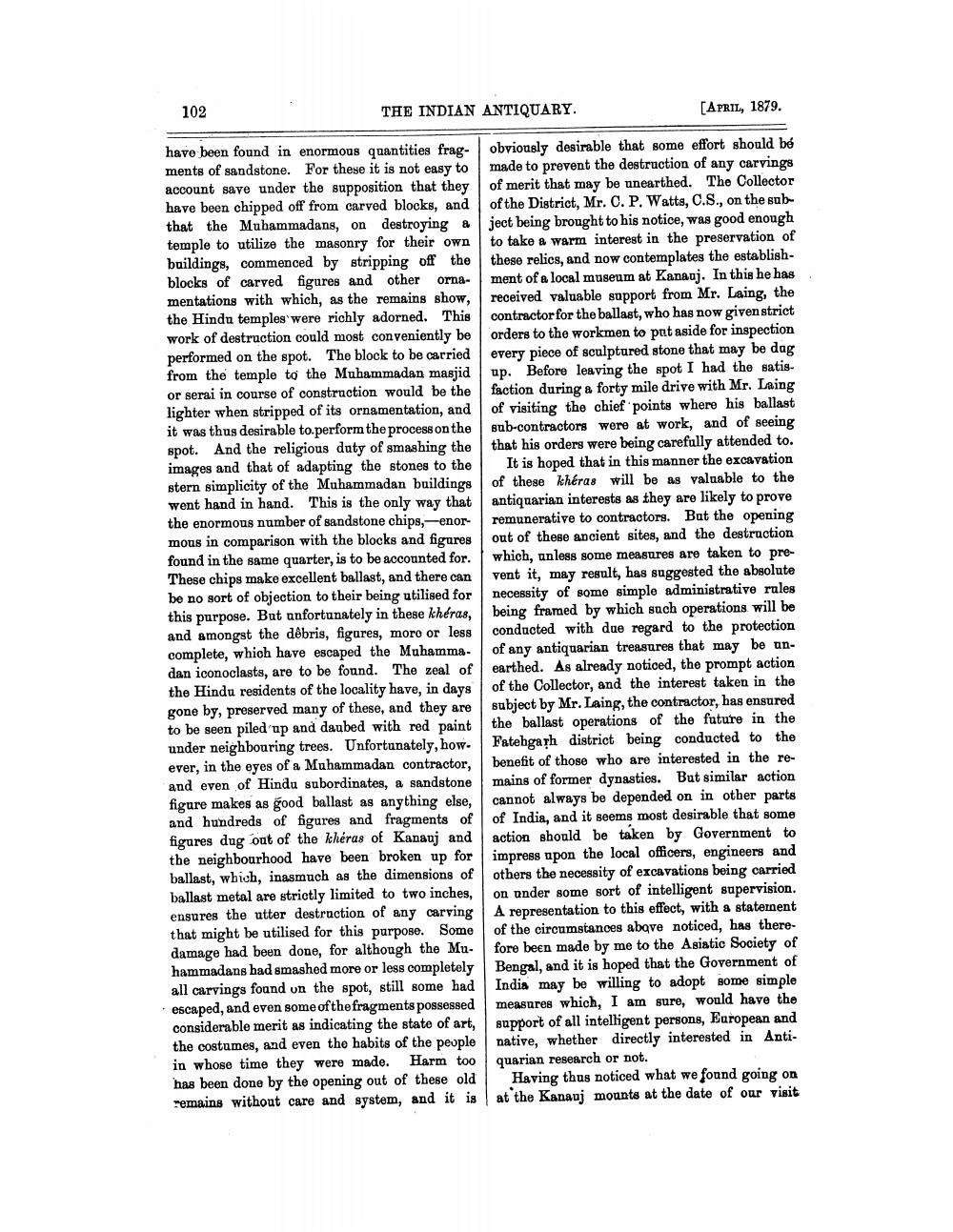________________
102
THE INDIAN ANTIQUARY.
have been found in enormous quantities fragments of sandstone. For these it is not easy to account save under the supposition that they have been chipped off from carved blocks, and that the Muhammadans, on destroying a temple to utilize the masonry for their own buildings, commenced by stripping off the blocks of carved figures and other ornamentations with which, as the remains show, the Hindu temples were richly adorned. This work of destruction could most conveniently be performed on the spot. The block to be carried from the temple to the Muhammadan masjid or serai in course of construction would be the lighter when stripped of its ornamentation, and it was thus desirable to perform the process on the spot. And the religious duty of smashing the images and that of adapting the stones to the stern simplicity of the Muhammadan buildings went hand in hand. This is the only way that the enormous number of sandstone chips,-enor mous in comparison with the blocks and figures found in the same quarter, is to be accounted for. These chips make excellent ballast, and there can be no sort of objection to their being utilised for this purpose. But unfortunately in these khéras, and amongst the dêbris, figures, more or less complete, which have escaped the Muhammadan iconoclasts, are to be found. The zeal of the Hindu residents of the locality have, in days gone by, preserved many of these, and they are to be seen piled up and daubed with red paint under neighbouring trees. Unfortunately, how. ever, in the eyes of a Muhammadan contractor, and even of Hindu subordinates, a sandstone figure makes as good ballast as anything else, and hundreds of figures and fragments of figures dug out of the khéras of Kanauj and the neighbourhood have been broken up for ballast, which, inasmuch as the dimensions of ballast metal are strictly limited to two inches, ensures the utter destruction of any carving that might be utilised for this purpose. Some damage had been done, for although the Muhammadans had smashed more or less completely all carvings found on the spot, still some had escaped, and even some of the fragments possessed considerable merit as indicating the state of art, the costumes, and even the habits of the people in whose time they were made. Harm too has been done by the opening out of these old remains without care and system, and it is
[APRIL, 1879.
obviously desirable that some effort should be made to prevent the destruction of any carvings of merit that may be unearthed. The Collector of the District, Mr. C. P. Watts, C.S., on the subject being brought to his notice, was good enough to take a warm interest in the preservation of these relics, and now contemplates the establishment of a local museum at Kanauj. In this he has received valuable support from Mr. Laing, the contractor for the ballast, who has now given strict orders to the workmen to put aside for inspection every piece of sculptured stone that may be dag up. Before leaving the spot I had the satisfaction during a forty mile drive with Mr. Laing of visiting the chief points where his ballast sub-contractors were at work, and of seeing that his orders were being carefully attended to.
It is hoped that in this manner the excavation of these khéras will be as valuable to the antiquarian interests as they are likely to prove remunerative to contractors. But the opening out of these ancient sites, and the destruction which, unless some measures are taken to prevent it, may result, has suggested the absolute necessity of some simple administrative rules being framed by which such operations will be conducted with due regard to the protection of any antiquarian treasures that may be unearthed. As already noticed, the prompt action of the Collector, and the interest taken in the subject by Mr. Laing, the contractor, has ensured the ballast operations of the future in the Fatehgarh district being conducted to the benefit of those who are interested in the remains of former dynasties. But similar action cannot always be depended on in other parts of India, and it seems most desirable that some action should be taken by Government to impress upon the local officers, engineers and others the necessity of excavations being carried on under some sort of intelligent supervision. A representation to this effect, with a statement of the circumstances above noticed, has therefore been made by me to the Asiatic Society of Bengal, and it is hoped that the Government of India may be willing to adopt some simple measures which, I am sure, would have the support of all intelligent persons, European and native, whether directly interested in Antiquarian research or not.
Having thus noticed what we found going on at the Kanauj mounts at the date of our visit




